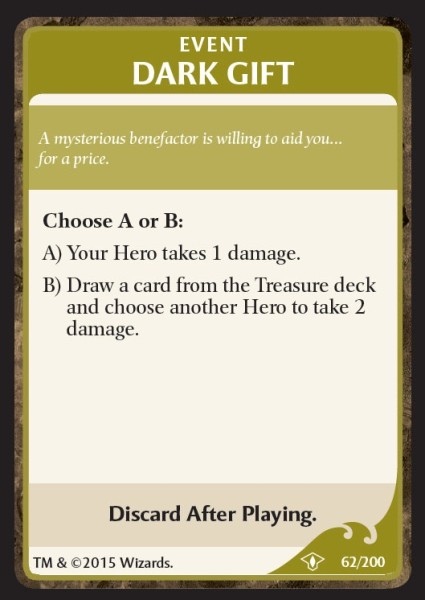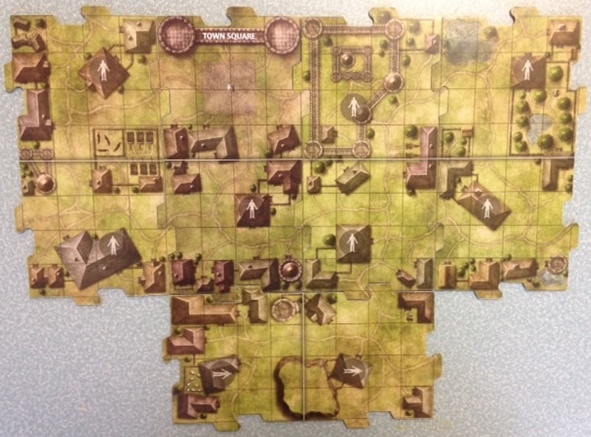Designer Diary: Temple of Elemental Evil Board Game

The fine folks over at Boardgame Geek have a few “designer Diary” up for the new Temple Of Elemental Evil board game.
He starts out with a nice big Spoiler Warning, which I will quote:
SPOILER WARNING: I’m going to talk about the structure of the Temple of Elemental Evil board game’s story, which may be considered spoilers. For those of you who want to experience the story first, I would suggest waiting to read this until after you’ve played through the campaign.
Mr Lee breaks down the 3 acts you will be playing through:
In Act 1, your protagonist is an Orphan. This can be either a literal or a figurative orphan. All that matters is that the hero of your story is isolated from something. For example, Luke Skywalker is a literal orphan, living with his aunt and uncle and feeling detached from their farming lifestyle. Tony Stark is not a team player in the beginning of The Avengers and is emotionally isolated from the rest of the team. Near the end of Act 1, the hero must make a decision that forms the core of the story and transitions him or her to the next stage.
You can see all 3 acts over in his post if you wish to find out more.
Mr. Lee then goes on to reveal some more of how they brought the Temple to the Adventure board game system:
In early 2014, we started sketching out the story for Temple of Elemental Evil. We knew we wanted around thirteen Adventures, and I realized that this story structure would function within the game. We needed to spend some time in each part of the story, so certain adventures mark the transition of the characters. We decided this transition would occur around Adventures 3, 7, and 11. That means Adventures 1-3 are Act I, Adventures 4-7 are Act 2 part 1, Adventures 8-11 are Act 2 part 2, and Adventures 12-13 are Act 3.
One important part of the original Temple of Elemental Evil TRPG adventure was the village of Hommlet. We felt the interaction of the elemental cults with the local populous was an important part of the story, so we wanted to make sure our story had the same resonance. Since our story is set in the Forgotten Realms, we picked the city of Red Larch as the focal point of the three transitional adventures.
We’ve never set an Adventure System game in a city, and it took a bit of a leap to figure out how this would function in the game. Since the town was going to be a separate area than the dungeon, we were able to use the back side of the five double-sized tiles which we haven’t been able to do in previous Adventure System games. I’ve tried to make town tiles before and failed because the completed town always looked odd when compared to the scale of the dungeon. The town worked once we changed the scale of the tiles from the typical 1 inch = 5 feet scale that we’ve used for the rest of the tiles.
I was VERY happy to see that are including the Village Of Hommlet!!
Mr Lee then breaks down some of the design:
Designing Act 1
All the adventure system games start with a solo adventure so the person who bought the game can sit down and learn how to play, making it easier for that player to teach the rest of the group. Since the heroes at this stage of the game should be orphans, we started the heroes off as the only survivors of a failed adventuring party. This also establishes that the heroes are characters that aren’t proven to be able to work together yet.Beyond setting up the heroes as orphans, Act 1 needs to introduce the cult of elemental evil to the players and the town of Red Larch. Episode 2 introduces one of the elemental cults, and Episode 3 introduces the town and the troubles that it has. The goal of the first town adventure is to establish that the cults are an active threat, which pushes the heroes to start exploring the main temple.
Finally, as there are four parts to the story and four elemental cults, it makes sense that each section focuses on one of the four element cults. The order that the cults are encountered was dictated by the miniatures we had available. Since we don’t have a monstrous leader of the Cult of the Howling Hatred (Air) that became the cult for Act 1. The salamander Arkashic Thunn is the least imposing of the three main villains, so the Cult of the Eternal Flame (Fire) is the main enemy for the first part of Act 2. The ettin Swerglemergle is next, so the Cult of Black Earth (Earth) is the main foe for the second half of Act 2. Finally, the black dragon Velathidros is the final villain and part of the Cult of the Crushing Wave (Water).
You can read the rest over in his post.
And now we move over to Part 2 from Ben Petrisor.
Mr. Petrisor starts off with a SPOILER Warning as well:
SPOILER WARNING: I’m going to talk about the structure of the Temple of Elemental Evil board game’s story, which may be considered spoilers. For those of you that want to experience the story first, I would suggest waiting to read this till after you’ve played through the campaign.
He starts saying:
there are several narrative themes we wanted to convey in the Temple of Elemental Evil board game: isolation, hidden evil, trust, and empowerment. These elements are enforced throughout the encounter deck, monster deck, and even the tiles themselves.
 Dark Gift: This was one of the first cards I designed for the game and the one I’m proudest of. It captures all the themes and creates different tension depending on when you draw it. Early in an adventure, it seems like a no-brainer: “I’ll just give the character with the most health two damage and draw treasure. Maybe make a fun little jab while I’m at it.” However, when it’s late in an adventure and the party is worn down, it becomes a much heavier risk/reward scenario that can tip the scales.
Dark Gift: This was one of the first cards I designed for the game and the one I’m proudest of. It captures all the themes and creates different tension depending on when you draw it. Early in an adventure, it seems like a no-brainer: “I’ll just give the character with the most health two damage and draw treasure. Maybe make a fun little jab while I’m at it.” However, when it’s late in an adventure and the party is worn down, it becomes a much heavier risk/reward scenario that can tip the scales.
 Doppelgänger: I saw doppelgänger on the miniatures list and immediately wanted to mimic its iconic affinity for subterfuge. Originally, it copied the A.I. and attacks of another monster, but that broke when they were alone. We played with ideas involving other monsters and players. Eventually, we settled on the final design in which the doppelgänger reveals itself to have replaced one of the party members and attacks. Narratively, it doesn’t make a lot of sense in a single-player session, but I’m happy with its use in a multi-player game.
Doppelgänger: I saw doppelgänger on the miniatures list and immediately wanted to mimic its iconic affinity for subterfuge. Originally, it copied the A.I. and attacks of another monster, but that broke when they were alone. We played with ideas involving other monsters and players. Eventually, we settled on the final design in which the doppelgänger reveals itself to have replaced one of the party members and attacks. Narratively, it doesn’t make a lot of sense in a single-player session, but I’m happy with its use in a multi-player game.
He goes on to talk about some of the traps and some of the other monsters that you will face, you can read more in his post.
Humor
A major understated element of D&D is humor. From weird bickering cultists and flumphs in an adventure module to Minsc & Boo in Baldur’s Gate, humor breaks monotony and shines like a beacon in the bleakest stories. Flavor text is a great space to add humor to a board or card game, and I hope you get a laugh out of them, but we also leveraged other spaces for D&D fans. Ettin’s are two-headed giants whose individual heads have a separate name that combines into one goofy name, hence the birth of Swerglemergle. (Fun fact: I did several searches because I was worried about unknowingly using a euphemism.)
I like the fact, they are including some humor into this! As at my gaming table (With the group friends I always play with) there is always a ton of Humor. I think we spend more time, laughing then playing!
Dungeons & Dragons: Temple of Elemental Evil Board Game is set to release on April 29th and can be Pre Ordered from Amazon.
Discover more from DDO Players
Subscribe to get the latest posts sent to your email.





Leave a Comment